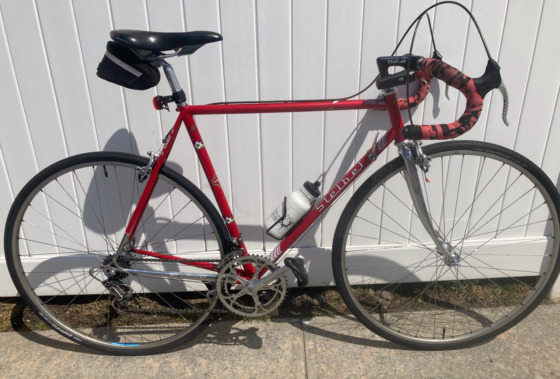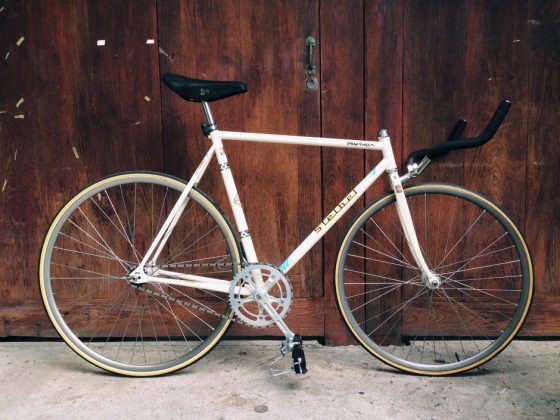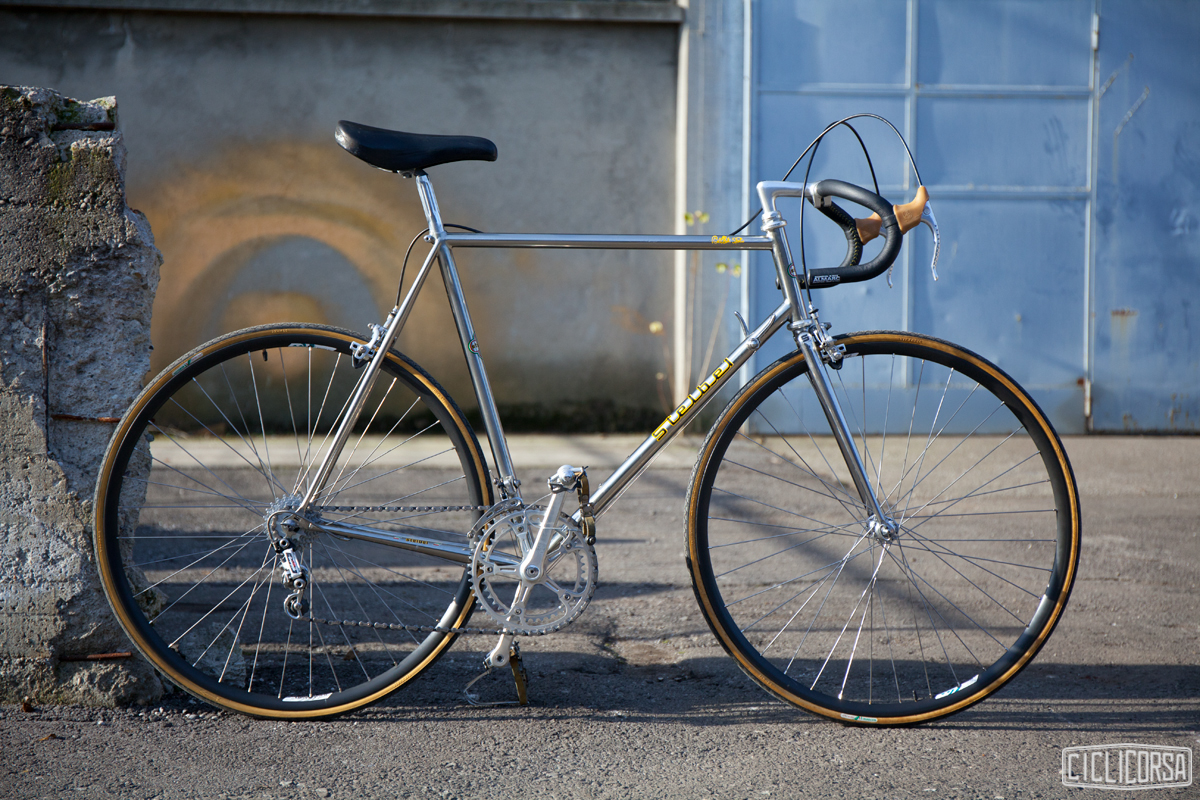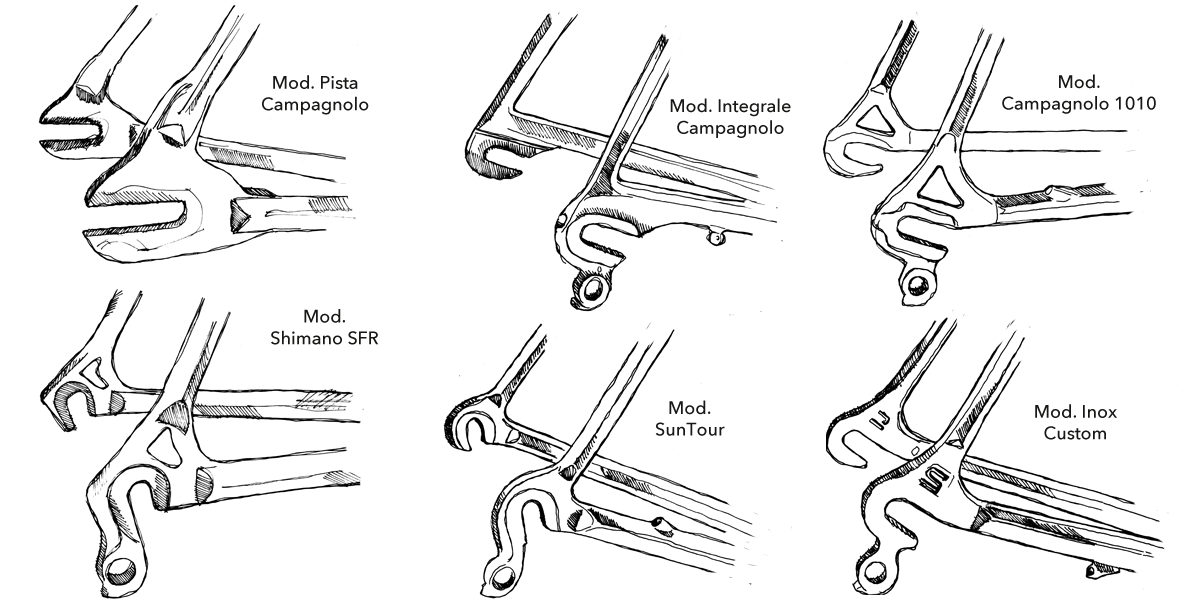| 088 |
- |
Stelbel Strada |
1985 |
M.M. |
U.S.A. (NYC) |
One of the very few Stelbel bike sent to the US back in the 80’s. More precisely, a Stelbel Strada made out of Columbus SL tubing, built and shipped to New York in 1985. Still owned by the original owner. Really well kept, with the original paint and equipped with a full Super Record groupset.
|
Gallery
|
| 087 |
- |
Dynamic Crono |
1986 |
A.Z. |
|
Dynamic model chronometer bicycle, 28 ″ -26 ″ wheels, built in 1986 with Columbus tubing, spoiler at the head tube and at the saddle section. The fork is of the fourth generation of 26 “, the bike in original condition has been restored and equipped with a Campagnolo groupset.
|
Gallery
|
| 088 |
573 |
Integrale |
1974 |
P.M. |
Italy |
Integrale 1974, one of the first creations of Stelio and Officina Belletti. With this frame you can see what distinguishes the artisan production from the standard production work. Featuring a classic first generation fork, with tig welding typical of the very first Stelbel frames, the passage for the rear brake cable is made by hand. The frame shows a faithful restoration of the first frames by Stelbel, equipped with a Campagnolo groupset, it is one of the rarest bicycles in the entire historic Stelbel register.
|
Gallery
|
| 086 |
- |
Inox |
1988 - 1990 |
A.Z. |
Italy |
Racing bicycle built at the end of the late 80s/early 90s. Stainless steel tubing was used for the frame and fork, the rear dropouts were produced internally. The frame is in excellent state condition, the finish is mirror-polished, the decals are original and on the top tube it bears Stelio’s hamdmade signauture.
|
Gallery
|
| 085 |
- |
Ciclocross |
1982 - 1984 |
A.Z. |
Italy |
Stelio has always been a great lover of Cyclocross, since the end of the 70’s he had tried his hand at building specific frames for races in muddy circuits. This example is one of the few frames still in circulation, made with Columbus tubes with internal reinforcements on the corners and in the head tube. The bike was built at the beginning of the 80s.
|
Gallery
|
| 084 |
- |
Integrale |
1978 |
A.Z. |
Italy |
Stelbel Integrale model from 1978. The second generation fork has reinforcements on the upper and external sections. Original bordeaux painting. Assembly is with Campagnolo New Record components, Ft Bologna hubs with Nisi Sludi rims and Vittoria Formula 1 tubulars.
|
Gallery
|
| 083 |
- |
Dynamic Strada |
1987 |
F.P. |
Swiss |
Stelbel Dynamic, built in 1987 as indicated by the punching on the bottom bracket. The frame is built with star shaped tubes, features the classic head tube spoiler, a typical feature of the Dynamic models, the cabling is internal and the fork is of the fifth generation. The frame is in an excellent condition, even the painting (cromovelata) is in an original state. Equipped with Shimano Dura-Ace unit and AX brakes
|
Gallery
|
| 082 |
- |
Integrale |
1978-1980 |
M.B. |
Swiss |
Stelbel Integrale model with typical dropouts welded directly to the chain stays,second generation fork, year of construction between 1978-80. The frame has been restored and fitted with a Campagnolo Super Record groupset.
|
Gallery
|
| 081 |
- |
Dynamic |
1987 |
E.M. |
Italy |
Stelbel Dynamic, built in 1987 (as indicated by the stamping on the bottom bracket). Originally built for the Capella dealer in Turin, it has recently been restored. Special features of the Dynamic model are the aerodynamic features of the frame, generally used on time trial frames and track tracking, there are several racing frames that have these characteristics. The cabling for both gears and brakes are internal.
|
Gallery
|
| 079 |
- |
Strada |
1991 - 1993 |
A.O. |
Italia |
Stelbel Strada model, made towards the end of the Stelbel production, the year is not clear but it is assumed to be the beginning of the 90s. Deda tubing with reduced thickness and unicrown fork identify an era of strong change in the production of handcrafted frames. The bicycle was autographed recently by Stelio himself.
|
Gallery
|
| 079 |
- |
Strada |
1983 - 1984 |
E.M. |
Italia |
Stelbel Strada model, SunTour dropouts and fourth generation fork suggest that the year of production may be around 1983 – 1984. Owned in the years that production frames were punched with a code indicating the year of production. The frame has been restored and is equipped with a Campagnolo Triomphe groupset.
|
Gallery
|
| 019 |
- |
Integrale |
- |
CC |
Italia |
Telaio modello Integrale atipico per via dei primi forcellini Shimano SFR, in tubazioni columbus è stato completamente cromato, purtroppo i passacavi del freno posteriore sono stati rimossi. Testa forcella di seconda generazione, saldature, limature ed altri dettagli ci fanno credere che sia un telaio costruito nel 1977. Il set di marche è stato applicato nuovamente.
|
Gallery
|
| 018 |
- |
Integrale |
- |
CC |
Italia |
Stelbel Integrale frame, with a typical dropout welded low in respect to the chainstays, the fork is second generation, we believe it was built in 1978, the engraving on the head tube is one of the first styles adopted by Stelio. The bicycle is in original condition, well preserved and fitted with Campagnolo Nuovo Record groupset.
|
Gallery
|
| 017 |
- |
Strada – Oria |
- |
CC |
Italia |
Stelbel bicycle built with Oria tubing with a star section, the year of production is not known, we suspect that it was built between 1984 and 1987. The fork is of the fourth generation, internal brake cabling and a classic seat post binder. The bicycle is in original condition, only a new set of decals has been applied. Mounted with a non-complete Campagnolo C-Record groupset.
|
Gallery
|
| 016 |
85350 |
Inox |
1985 |
C.C. |
Italia |
One of the first stainless steel Stelbel frames built by the Belletti workshop. Some accessories such as dropouts and cable inserts are made of steel, the third generation fork is made of stainless steel. The frame has been restored with the same technique originally used, Wood’s Nickel, and is built with a period correct Campagnolo Super Record groupset.
|
Gallery
|
| 015 |
86023 |
Strada |
1986 |
C.C. |
Italia |
Stelbel Strada model, built in 1986, the fork is a fifth generation, Stelbel stamped on the dropouts and internal rear brake cable. The frame is in the original condition and is fitted with a Campagnolo Super Record groupset.
|
Gallery
|
| 078 |
8941 |
Strada – Oria |
1989 |
E.M. |
Italy |
Strada model, made with star-shaped Oria with a fifth-generation fork. The bottom bracket has an aero spoiler, Columbus dropouts and a classic seat binder. The bicycle has been restored with third generation dropouts and is equipped with a complete Shimano Dura-Ace groupset.
|
Gallery
|
| 077 |
8720 |
Strada |
1987 |
A.Z. |
Italy |
1897 Stelbel Strada road frame build with Columbus tubing, with an oval top tube. Fork has an atypical construction, although an original Stelbel fork, it is one of the few that has a fork crown that differs from the ones on file, with Campagnolo-style 1010 dropouts with a punched Stelbel logo.
This road bike is in excellent condition, with original and well-preserved decals and paint, as well as Stelio Belletti’s signature. The frame is mounted with a Campangolo C-Record groupset.
|
Gallery
|
| 076 |
89133 |
Inox |
1989 |
G.Z. |
Italy |
Road bicycle built in 1989. Both fork and frame are made with stainless steel tubing. The rear dropouts were produced internally at Stelbel. The bicycle is mounted with a Campagnolo 50th Anniversary groupset and both frame and groupset are very well preserved. The frame has been mirror polished and the decals are original.
|
Gallery
|
| 075 |
|
Integrale |
1977 |
M.B. |
Italia |
A variation on the standard Integrale model, constructed in 1977, with a second generation fork and dropouts similar to the Shimano SFR dropouts. The frame was restored in 2016 by Stelbel, and the color was sampled from a original vintage Stelbel frame. The reproduced decals are faithful to the original.
|
Gallery
|
| 074 |
- |
Integrale |
1978 |
M.R. |
Italy |
1978 Stelbel Integrale, as indicated by the 2nd generation fork, non-pantographed head tube, and original paint. These features indicate that this frame was built in a transition period in which the decals used went from 2nd to 3rd generation. Mounted with a mix of Campagnolo, Universal, and Ofmega components.
|
Gallery
|
| 073 |
86193 |
Strada |
1986 |
C.O. |
Italy |
Strada model built in 1986, as indicated by the code on the bottom bracket shell and the 5th generation fork, seen on Stelbel frames from 1986-1990. This frame is in original condition mounted with a mix of components which are not period correct.
|
Gallery
|
| 072 |
8549 |
Strada |
1985 |
M.M. |
USA |
Strada model built in 1985, as indicated by the code punched into the bottom bracket shell and the 4th generation fork. Perfectly preserved, with original paint, decals and Campagnolo Super Record gruppo.
|
Gallery
|
| 071 |
- |
Stelbel Integrale |
|
C.C. |
Italy |
Stelbel Integrale road bicycle built with the characteristic Stelbel dropouts welded to the chainstays. This frame has a second generation fork. The headtube area has been reinforced on the top and down tube. It was fully restored in 2015 in the original classic “salmon pink”, and a mix of Campagnolo and Gipiemme.
|
Gallery
|
| 070 |
84318 |
Dynamic Cronometro |
1984 |
F.A. |
Italy |
Stelbel Dynamic time trial model with 28 “-26″. Built in 1984 with an aero gusseted steerer and bottom bracket shell. The fork is the fifth generation 26 ” fork, the bike is in original condition, the decals have been refreshed by owner.
|
Gallery
|
| 068 |
- |
Integrale |
1977 - 1978 |
|
Italy |
Integrale road bicycle model with typical dropouts welded directly to the chainstays, with a second-generation fork crown. The frame was restored at the beginning of 2016, and mounted with a coherent Campagnolo Nuovo Record group-set.
|
Gallery
|
| 069 |
86233 |
Strada |
1986 |
M.R. |
Italy |
Road model, build in 1986. Dated thanks to the punched bottom bracket shell and the fifth generation fork, produced from 1986 to 1990. This bicycle has been fully restored with all new chrome and has a Dura-Ace group-set.
|
Gallery
|
| 067 |
- |
Integrale |
1978 - 1979 |
V.F. |
Italy |
Integrale model built between 1978 and 1979. This frame can be dated as such thanks to the iconic dropouts welded to the lower portion of the chainstays and the lack of engraving on the steerer tube. The fork is a second generation fork. The frame has stickers from a Parma shopkeeper who sold Stelbel frames during that era.
|
Gallery
|
| 065 |
- |
Strada |
1980 - 1981 |
S.M. |
Italy |
Road bike model, produced between ’80 and ’81, a model that marks the transition from the Integral model to the Strada model. Notable features are the cone-shaped seatstays and the second generation fork. Very well preserved, with original decals and paint, the seat tube has the logo of the Stelbel retailer in Parma during that era.
|
Gallery
|
| 066 |
- |
Integrale |
1978 - 1979 |
M.T. |
Germany |
This Integrale road bicycle is atypical as it has Shimano SFR dropouts. Produced in the late 70s between 1978-1979, this bicycle has been restored. Decals are the third version and the fork is second generation.
|
Gallery
|
| 014 |
- |
Stelbel Strada |
1982 - 1983 |
C.C. |
Italia |
Restored Stelbel Strada with an original “Salmon Pink” paint scheme. The frame, like every Stelbel bicycle, was custom built to size: 63 x 60 c-c. The fork crown is one halfway between the second and third generation style of fork crown (third generation had a larger pantographed “S”).
|
Gallery
|
| 064 |
84215 |
Strada |
1984 |
F.M. |
Italy |
Road bicycle model built in 1984 in original condition, with a third generation fork. The fork is one of the last of this generation produced with 1984 being the year of transition between third and fourth generation forks. The head tube is pantographed, with external gear routing, and Stelbel punched front and rear dropouts.
|
Gallery
|
| 063 |
88095 |
Inox |
1988 |
R.M |
Italy |
Road bicycle built with stainless steel tubing. Classic style Columbus steel Rear dropouts, a glossy fade paint job with original decals, a third generation fork made out of stainless steel tubing.
|
Gallery
|
| 062 |
- |
Integrale |
1978-79 |
J.B. |
Austria |
A typical Integrale model with rear dropouts welded with a unique Stelbel technique, second generation fork crown with the typical rounded “S”. This frame was professionally restored in 2015 and mounted with high-end components of the same era as the frame.
|
Gallery
|
| 061 |
8573 |
Dynamic strada |
1985 |
M.B. |
Italy |
Stelbel Dynamic road model, easily recognisable thanks to the aerodynamic gussets, internal gear cable routing, and, like every Dynamic model, has an “S” within a 4-pointed star on the head tube. The bicycle is perfectly conserved, with original paint and third generation decals. The fork is fourth generation. The bicycle is mounted with a complete Campagnolo C-Record groupset, and the seatpost and stem have a “Stelbel” pantograph.
|
Gallery
|
| 059 |
88003 |
Strada – Oria |
1988 |
O.S. |
Italy |
Strada model road bicycle, made with star-shaped Oria tubing, and a fifth generation fork. Has a aerodynamic spoiler welded behind the bottom bracket between the chain stays. Bicycle has undergone a conservative restoration, is in its original condition, original paint with a fading fishnet paint job and third generation decals. Mounted with a complete Campagnolo C-Record and delta brakes.
|
Gallery
|
| 060 |
- |
Integrale |
1978 |
A. |
Italy |
A road version of the Integrale model, atypical due to the presence of Shimano SFR dropouts, the year of production is identified as 1978. Both the frame and the groupset are in their original condition, with third-generation decals and a fourth generation fork.
|
Gallery
|
| 056 |
86281 |
Super Strada – Oria |
1987 - 1988 |
T.U. |
Japan |
Super Strada road model, with an atypical fourth generation fork with an engraved fork crown and straight fork blades. Internal cable routing, star-shaped Oria tubing, aero gusset behind the bottom bracket, with the seat post held in place by a headless allen bolt. The bike has recently undergone a historically accurate restoration.
|
Gallery
|
| 034 |
|
Strada (Road) |
1982 - 1983 |
G.S. |
Italy |
Strada (road) model in very good condition, the fork crown is distinct in that it is halfway between a second and third generation fork (the “S” engraved on the fork crown is larger). Original paint and decals.
|
Gallery
|
| 035 |
- |
Strada (Road) |
1989 --> |
M.W. |
Scotland |
Strada (road) model built with Deda tubing with a reinforced seatpost binder, custom bent stays, and an oval seat tube. Mounted with a unicrown fork, and original paint and decals.
|
Gallery
|
| 036 |
|
Integrale |
1978 - 1979 |
M.W. |
Wales |
Integrale model road bicycle, one of the first with an engraved head tube. Second generation fork, the frame has been repainted and the decals are missing.
|
Gallery
|
| 037 |
- |
Strada (Road) |
1981 - 1982 |
A.D. |
Italy |
Strada (road) model with a second generation fork, a blue-to-white fade paint job and original decals. Mounted with a pantographed quill stem and seatpost.
|
Gallery
|
| 030 |
- |
Cronosquadra (Team Time Trial) |
1988 |
M.B. |
Switzerland |
Cronosquadra model (team time trial) frame, restored in 2013 and autographed by Stelio Belletti, with 28″-24″ wheels, Italian flag colours, and fifth generation fork.
|
Gallery
|
| 012 |
- |
Pista (Track) |
1977 |
C.C. |
Italy |
Pista model (track) without fork, construction and aesthetic details are typical of 1977. Paint color is typical of track models.
|
Gallery
|
| 010 |
- |
Integrale |
1978 |
C.C. |
Italy |
Integrale model with typical rear dropouts, a second generation fork, and original paint and groupset. One of the first frames with a third generation decals and pantographed head tube.
|
Gallery
|
| 009 |
87106 |
Strada (Road) |
1987 |
C.C. |
Italy |
Strada (road) model, constructed for an official Turinese dealer, Cicli Capella. Original paint, uni-crown fork, and original groupset.
|
Gallery
|
| 008 |
87105 |
Strada (Road) |
1987 |
M.Z. |
Italy |
Strada (road) model, well-preserved and autographed by Stelio Belletti, with original paint and decals and a fifth generation fork. The bicycle is mounted with a complete Campagnolo Super Record groupset.
|
Gallery
|
| 031 |
87033 |
Strada (Road) |
1987 |
A.B. |
Italy |
Strada (road) model built with star-shaped Oria tubes, a fifth generation fork, classic campagnolo dropouts, modified cable routing (originally internal). Paint job is not original.
|
Gallery
|
| 055 |
- |
Strada |
1979 - 1980 |
A.B. |
Italy |
A restored Strada (road) model. Uniquely welded external brake and rear derailleur cable housing. Modified derailleur mount welded directly to the seat tube. Second generation fork. The bicycle was restored in 2014.
|
Gallery
|
| 032 |
894 |
Super Strada (Road) |
1989 |
W.G.A. |
Austria |
A Super Strada (road) model made with Columbus tubing. Internal cable routing with top mount downtube shifters, a fifth generation fork with a “squared S” panto on the crown compatible with 1987-1990 models and beyond. Restored and personally autographed by Stelio Belletti in 2013.
|
Gallery
|
| 033 |
87199 |
Dynamic Crono Time Trial |
1987 |
P.F. |
Germany |
Original time trial Dynamic model with 28″-26″ wheels, aerodynamics gussets on head tube, the top rear triangle, and between the lower stays behind the bottom bracket. The fork is fifth generation for a 26″ wheel, with original paint and decals.
|
Gallery
|
| 013 |
- |
Integrale oversize |
1977 |
C.C. |
Italy |
A special model, given the “Integrale” model name because of the year of production. The frame has distinct features such as 28.6 and 33mm oversize tubing that are not seen on other Integrale models. A notable feature is the use of Shimano SFR vertical dropouts. The fork is second generation typical of the Integrale model.
|
Gallery
|
| 005 |
- |
Road Tandem |
1978 |
C.C. |
Italy |
Men’s Road Tandem built in 1978 and restored in 2013, with a second generation fork. We believe this to be one of the first tandem frames built by the Belletti Workshop.
|
Gallery
|
| 007 |
84229 |
Super Strada |
1984 |
C.C. |
Italy |
Road racing bicycle, perfectly conserved with a fourth generation fork and internal cable housing. The seatpost is held in position by a headless allen bolt. Bicycle is mounted with the original vintage groupset, with modified brake levers and an Almarc leather handlebar covering.
|
Gallery
|
| 004 |
- |
Integrale Time Trial |
1978 |
C.C. |
Italy |
A time trial version of the Integrale model with aerodynamic ovalized tubing. The frame was restored in 2013. Interesting details are the shifter lever welded to the frame, and the rear derailleur shifter mounted to the handlebars. Second generation fork.
|
Gallery
|
| 057 |
- |
Integrale |
1978 - 1979 |
T.U. |
Japan |
Integrale model from the late 70s, the paint was probably redone in the mid-80s (1986), the rear dropouts are typical of this model, as is the fork.
|
Gallery
|
| 058 |
- |
Strada x Aliverti |
1986 - 1987 |
T.U. |
Japan |
Stelbel bicycle build for the bicycle dealer Aliverti. A Strada (road) model with a fourth-generation fork. Punched rear dropouts.
|
Gallery
|
| 054 |
- |
Integrale |
1978 |
A.F. |
Italy |
Atypical Integrale model due to the road dropouts. Year of production indicated as 1978, in original condition without decals, second generation fork.
|
Gallery
|
| 053 |
- |
Pista Inseguimento (Track Pursuit) |
1983 - 1984 |
Y.P.C. |
Thailand |
Track pursuit bicycle with 28”-26” wheels. An interesting detail is the stem insert, which is inserted below, between the wheel and headset to increase the inclined position of the rider. Built between 1983-1984, with ovalized tubing and a fourth generation fork. It was restored in 2014 and signed by Stelio Belletti.
|
Gallery
|
| 052 |
- |
Super Strada |
1980 - 1984 |
D. |
Italy |
Super Strada road bicycle model, due to the internal cable routing. Built between 1980 and 1984, with an engraved head tube, atypical use of a second-generation fork without the “S” engraved on the fork crown. Original with incomplete decals.
|
Gallery
|
| 051 |
- |
Integrale |
1978 - 1980 |
M.B. |
Italy |
Atypical Integrale model due to the road version of the rear dropouts, year of production is between 1978 and 1980, in original condition with original third-generation decals, second-generation fork, and seat post held in place by a headless allen bolt. Original red paint with black pinstriping, with it’s original groupset with a 1978 Campagnolo Super Record gear shifter.
|
Gallery
|
| 050 |
- |
Integrale |
1978 |
M.D. |
Italy |
Atypical Integrale model due to the use of road dropouts, which, starting in 1979 was identified as the “Strada” (road) model. Welds on bottom bracket and stays have not been filed, in original condition with second-generation decals and fork, with the seat post held in place by a headless allen bolt. Stelbel saddle.
|
Gallery
|
| 049 |
84108 |
Dynamic strada |
1984 |
G.T. |
Italy |
Dynamic model of a road bike with an aerodynamic spoiler on the first-generation head tube, internal cable routing with top mount downtube shifters, seat post held in place by a headless allen bolt, original paint and decals. Third-generation fork.
|
Gallery
|
| 048 |
8991 |
Inox |
1989 |
E.S. |
Italy |
Road bike build with inox tubing, rear dropouts and fork. Gloss finish and original decals, with a stainless steel fourth-generation fork.
|
Gallery
|
| 047 |
- |
Tandem turismo Lui-Lei |
1984 - 1986 |
E.S. |
Italy |
Touring Tandem for him-her, conserved in perfect conditions with original groupset and a fourth-generation fork crown.
|
Gallery
|
| 046 |
- |
Strada |
1987 |
M.C. |
Italy |
Strada (road) model with unconventional ‘star-shaped’ Oria tubing, an option provided to customers at the time. Fifth-generation fork crown. Frame was recently restored with a cromovelato finish (transparent paint over chrome).
|
Gallery
|
| 045 |
- |
Integrale |
1977 - 1978 |
M.C. |
Italy |
Integrale model with typical dropouts and fork. Original Fishnet paint job from mid 80s. Mounted with a groupset from the same era.
|
Gallery
|
| 044 |
|
Tandem Corsa (Road) |
1984 - 1986 |
M. |
Italy |
Men’s road tandem in good condition with original paint and decals. Fourth-generation fork.
|
Gallery
|
| 043 |
|
Integrale |
1977 - 1978 |
D.V. |
Italy |
Integrale model with typical dropouts and second-generation fork. Excellently preserved with an original paint job, and second-generation decals.
|
Gallery
|
| 042 |
|
Integrale |
1979 |
P.S. |
Italy |
Integrale model in original conditions with second-generation fork. Original paint and decals.
|
Gallery
|
| 041 |
|
Strada |
1979 |
A.P. |
Italy |
One of the first Strada (road) models; well kept with original paint and decals. Seatpost is held in place by a headless allen bolt, a second-generation fork and chromed details. Mounted with a Campagnolo Super Record groupset.
|
Gallery
|
| 040 |
|
Integrale |
1975 - 1976 |
G.C. |
Italy |
Integrale road bicycle, one of the oldest in our registry, well-conserved, with first generation original decals, and the first type of self-centering modified dropouts. The fork is first generation. This frame has similar characteristics to the patented Integrale 1975 prototype.
|
Gallery
|
| 039 |
|
Strada – Cronometro (Road Time Trial) |
1979 - 1981 |
D.C. |
Italy |
Strada (road) model with time trial characteristics. Tubes have a reduced diameter (front triangle tubes are all 25.4) with a seat post diameter of 22.2m. Top mount down tube shifters with external cable routing. Original decals and paint, with a second-generation fork.
|
Gallery
|
| 038 |
|
Pista (Track) |
1977 |
J.N.G. |
Hong Kong |
Pista (track) model with the most evolved version of a first generation fork typical of 1977, with “salmon pink” paint job used often for track models, and second-generation decals.
|
Gallery
|
| 011 |
- |
Super Strada |
1982 |
C.C. |
Italy |
Super Strada road bicycle with internal cable routing, seat post held in positing by a headless allen bolt, fork is transitional between the second and third generation, original paint. Autographed by Stelio Belletti.
|
Gallery
|
| 006 |
- |
Tandem Turismo Lui-Lei |
1980 - 1982 |
C.C. |
Italia |
Touring Tandem Lui-Lei (his & hers) restored in 2014, with a second generation fork crown.
|
Gallery
|
| 003 |
88033 |
Inox |
1988 |
C.C. |
Italia |
Road bicycle with stainless steel tubing. The fork has straight blades and a “squared S” pantograph on the crown, typical of late 80s frames. The frame was polished and sealed, with original decals.
|
Gallery
|
| 001 |
86155 |
Dynamic Pista inseguimento |
1986 |
C.C. |
Italia |
Pursuit track bicycle with 28″-26″ wheels, built with the classic spoiler seen on Dynamic models, and mounted with a fifth generation fork for a 26″ wheel. The paint is original and is mounted with a Campagnolo track groupset.
|
Gallery
|
| 002 |
85128 |
Dynamic Cronometro |
1985 |
C.C. |
Italia |
Time trial bicycle with aerodynamic gussets, 28″-26″ wheels, a fourth generation fork and SunTour dropouts. The frame has been conserved in its original state.
|
Gallery
|











